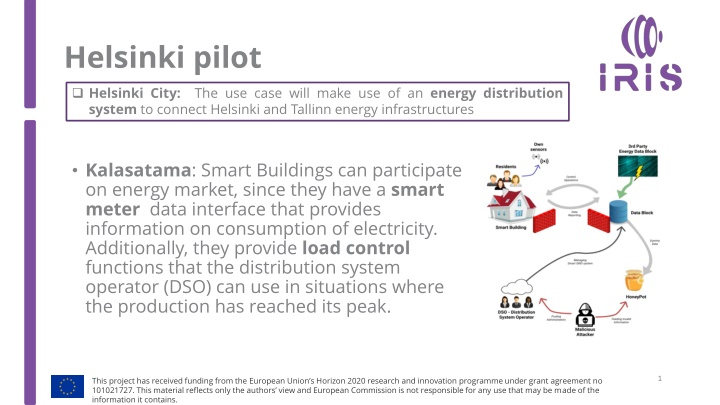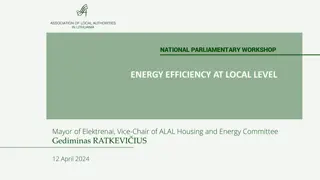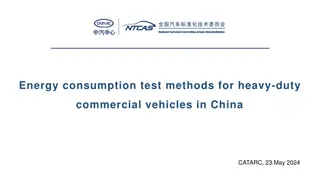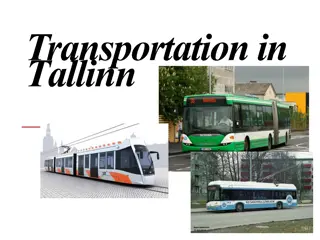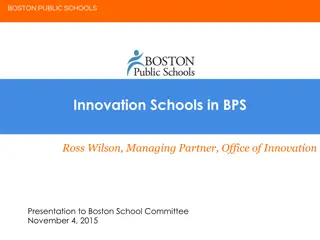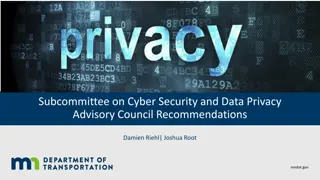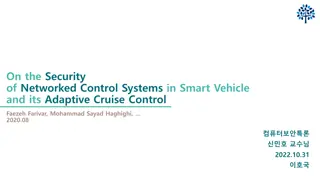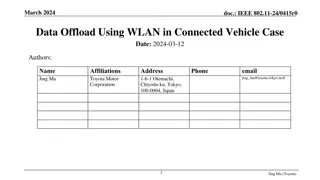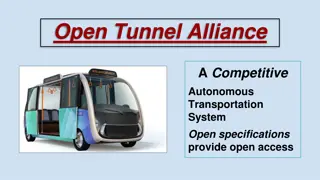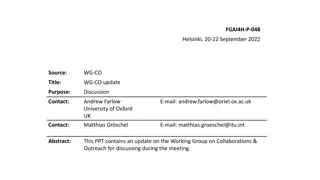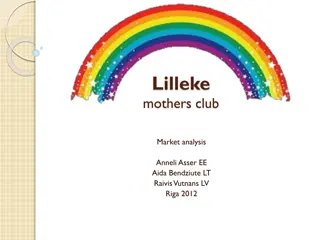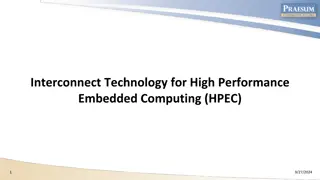Smart Energy and Autonomous Vehicles Pilot Projects in Helsinki and Tallinn
These pilot projects in Helsinki and Tallinn aim to revolutionize energy distribution and transportation through smart grid technologies and AI-enabled autonomous vehicles. The Helsinki pilot focuses on smart buildings participating in the energy market, while the Tallinn pilot features AI-enabled autonomous vehicle shuttles monitored by a remote operation center. Both projects address challenges in energy management, incident response, and autonomous vehicle operations, supported by Horizon 2020 funding.
Download Presentation

Please find below an Image/Link to download the presentation.
The content on the website is provided AS IS for your information and personal use only. It may not be sold, licensed, or shared on other websites without obtaining consent from the author.If you encounter any issues during the download, it is possible that the publisher has removed the file from their server.
You are allowed to download the files provided on this website for personal or commercial use, subject to the condition that they are used lawfully. All files are the property of their respective owners.
The content on the website is provided AS IS for your information and personal use only. It may not be sold, licensed, or shared on other websites without obtaining consent from the author.
E N D
Presentation Transcript
Helsinki pilot Helsinki City: The use case will make use of an energy distribution system to connect Helsinki and Tallinn energy infrastructures Kalasatama: Smart Buildings can participate on energy market, since they have a smart meter data interface that provides information on consumption of electricity. Additionally, they provide load control functions that the distribution system operator (DSO) can use in situations where the production has reached its peak. 1 This project has received funding from the European Union s Horizon 2020 research and innovation programme under grant agreement no 101021727. This material reflects only the authors view and European Commission is not responsible for any use that may be made of the information it contains.
Helsinki pilot Goals and Challenges: Effective incident response and threat intelligence collaboration for cross-border smart grid threats Secure customer-facing components: Against threats to control functions defined for the demand control Secure APIs: Smart Grid API from Kalasatama (district of Helsinki) Smart Grid APIs from the city of Tallinn. 2 This project has received funding from the European Union s Horizon 2020 research and innovation programme under grant agreement no 101021727. This material reflects only the authors view and European Commission is not responsible for any use that may be made of the information it contains.
Helsinki pilot: Cyber Range This demonstration will be emulated as a cross-border crisis management exercise on the Virtual Cyber Range (VCR), with Digital Twins of the target smart grid systems, as well as Digital Twin honeypots 3 This project has received funding from the European Union s Horizon 2020 research and innovation programme under grant agreement no 101021727. This material reflects only the authors view and European Commission is not responsible for any use that may be made of the information it contains.
Tallinn pilot Featuring: AI-enabled autonomous vehicle shuttles (AV shuttle) that are monitored by a centralized remote operation centre. Goals and Challenges: Ensuring availability of data and the operations of autonomous vehicle and supporting infrastructure. Lack of investigation of cyber defence mechanisms that facilitate autonomous detection and risk-based response for privacy breaches. 4 This project has received funding from the European Union s Horizon 2020 research and innovation programme under grant agreement no 101021727. This material reflects only the authors view and European Commission is not responsible for any use that may be made of the information it contains.
Barcelona pilot Featuring: AI computer vision system and an IoT infrastructure deployed at a Tramway station to avoid potential accidents between bicycles and pedestrians getting off the train. Goals and Challenges: Ensuring availability of IoT and IA infrastructure for the safety of tram users. Lack of experience as well as of tools, for detecting and reporting IoT & AI attack vectors. 5 This project has received funding from the European Union s Horizon 2020 research and innovation programme under grant agreement no 101021727. This material reflects only the authors view and European Commission is not responsible for any use that may be made of the information it contains.
Key takeaways Smart Cities => novel, cutting edge AI/IoT-driven technology This implies Emerging Threats ! High risks! Currently, lack of experience as well as of tools for incident management that tackle IoT & AI attack vectors IRIS will enhance the capabilities (knowledge, toolset, training) of CERTs/CSIRTs, to address these challenges. This project has received funding from the European Union s Horizon 2020 research and innovation programme under grant agreement no 101021727. This material reflects only the authors view and European Commission is not responsible for any use that may be made of the information it contains.
Thank you for your attention! iris-h2020.eu Gon alo Cadete (INOV) IRIS H2020 Project iris_h2020 This project has received funding from the European Union s Horizon 2020 research and innovation programme under grant agreement no 101021727. This material reflects only the authors view and European Commission is not responsible for any use that may be made of the information it contains.
IRIS Objectives To identify the user, technical and business requirements and design the architecture of an AI threat reporting and incident response system To analyze the relevant ethics principles and legal framework on privacy concerns To develop a collaborative platform for ICT stakeholders and European CERTs/CSIRTs for the successful operation of IoT and AI-enabled ICT systems To demonstrate and validate the integrated IRIS platform across three realistic pilot demonstrators in three smart cities To ensure wide communication and scientific dissemination of the IRIS results, efficient exploitation and contribution to relevant standardization bodies 8 This project has received funding from the European Union s Horizon 2020 research and innovation programme under grant agreement no 101021727. This material reflects only the authors view and European Commission is not responsible for any use that may be made of the information it contains.
IRIS Methodology 9 This project has received funding from the European Union s Horizon 2020 research and innovation programme under grant agreement no 101021727. This material reflects only the authors view and European Commission is not responsible for any use that may be made of the information it contains.
IRIS Pilots: Pilot Use Case 1 Securing the smart city s IoT and control systems against confidentiality and integrity breaches (Barcelona, Spain) 10 This project has received funding from the European Union s Horizon 2020 research and innovation programme under grant agreement no 101021727. This material reflects only the authors view and European Commission is not responsible for any use that may be made of the information it contains.
Barcelona pilot: threat scenarios On-Street cameras generate information about the intersection status. This information is used by Tramway operators to control (allow/disallow) the Tramway. This information is shared through an API. Threat Actor Injects fake data by targeting the different hardware appliances in the scenario with the goal of either denying the service, thus forcefully stopping the Tramway, or faking the presence of a possible pedestrian or bicycle approaching the intersection. IRIS ATA module is able identify actionable and accurate cyber threats against the availability of the supporting infrastructure. Also, IRIS will assist CERT investigation and incident response through the CTI module, Sharing the information about the attacks and security breaches. CERT and Tramway operators are notified by IRIS Platform. This project has received funding from the European Union s Horizon 2020 research and innovation programme under grant agreement no 101021727. This material reflects only the authors view and European Commission is not responsible for any use that may be made of the information it contains.
IRIS Pilots: Pilot Use Case 2 Securing AI-enabled infrastructure of autonomous transport systems in a smart city (Tallinn, Estonia) 12 This project has received funding from the European Union s Horizon 2020 research and innovation programme under grant agreement no 101021727. This material reflects only the authors view and European Commission is not responsible for any use that may be made of the information it contains.
Tallinn Pilot: threat scenarios Availability of telemetric data from the AV to the Urban Operating Platform (UoP) False information being fed to disrupt the ML/AI used for autonomous driving 13 This project has received funding from the European Union s Horizon 2020 research and innovation programme under grant agreement no 101021727. This material reflects only the authors view and European Commission is not responsible for any use that may be made of the information it contains.
IRIS Pilots: Pilot Use Case 3 Effective incident response and threat intelligence collaboration for critical cross-border smart grid threats (Helsinki, Finland and Tallinn, Estonia) 14 This project has received funding from the European Union s Horizon 2020 research and innovation programme under grant agreement no 101021727. This material reflects only the authors view and European Commission is not responsible for any use that may be made of the information it contains.
